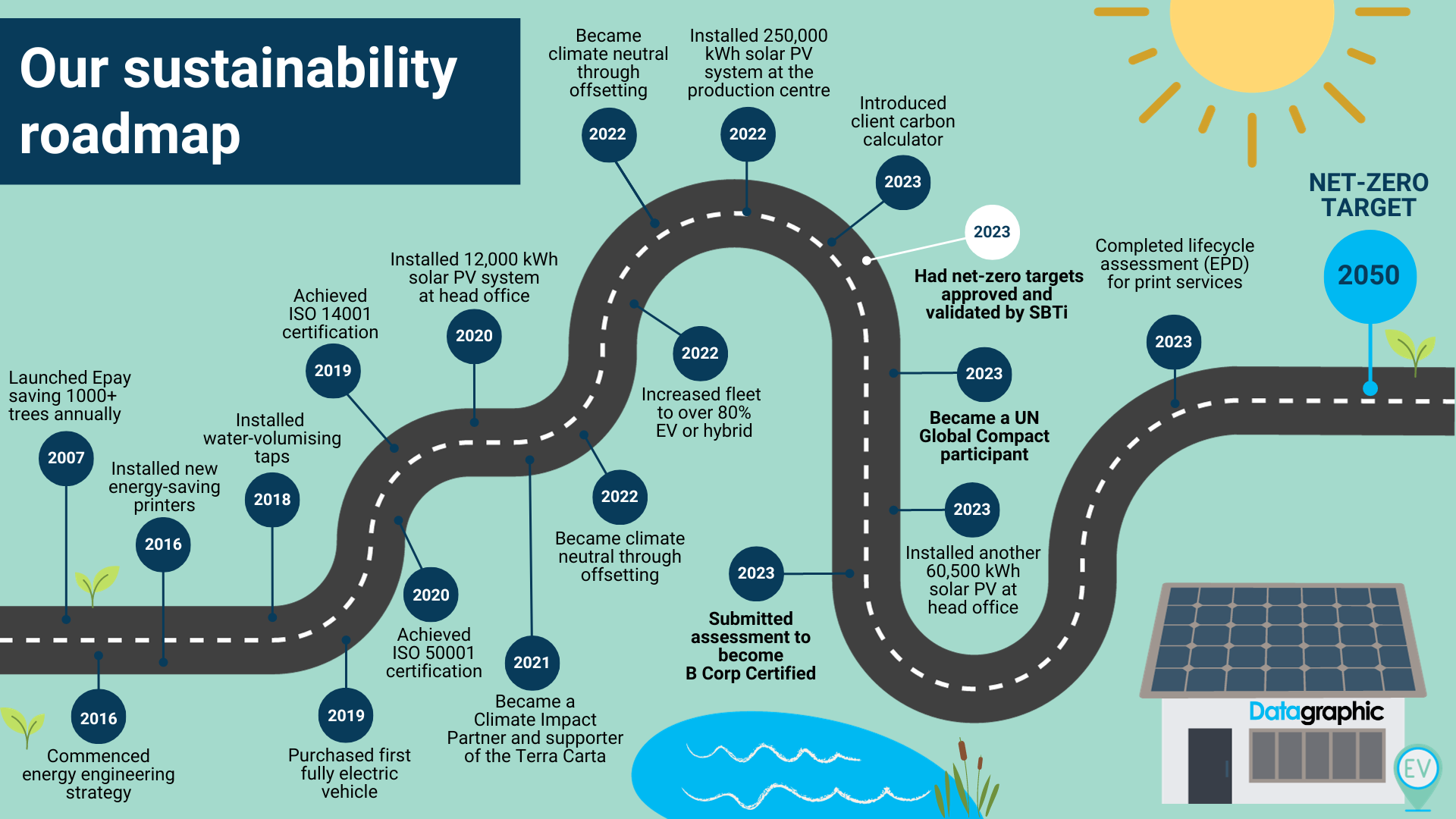Achieving a zero-carbon economy requires organisations to work innovatively to build sustainable growth.
Datagraphic is pleased to be an organisation committed to ambitious, science-based carbon emissions reduction targets. Our targets have now been approved and validated by the Science Based Targets initiative (SBTi).
In fact, we are the only UK SME in our industry with near-term, long-term and net-zero targets approved and validated by the SBTi.
A science-based approach to carbon reduction
Datagraphic’s net-zero carbon strategy commits to decarbonising our entire UK operations and the steps we take to operate as a sustainable business.
We work with specialist energy engineers, Pro Enviro, who help us monitor and record carbon emissions. Our strategy, therefore, remains aligned with the UK Government’s commitment under the Climate Change Act.
Using the Greenhouse Gas (GHG) Protocol, we document results annually against the baseline year of 2019 to track our progress against our quantifiable objectives.
Subsequently, this latest validation from the SBTi recognises that Datagraphic is taking quantifiable, science-based steps towards achieving our targets.
What are science-based targets?
The SBTi drives ambitious climate action in the private sector by enabling organisations to set science-based emissions reduction targets.
For this reason, science-based targets provide a clearly-defined path to reduce greenhouse gas emissions. Taking a scientific approach towards sustainability means we help to prevent the worst impacts of climate change and future-proof business growth in line with the goals of the Paris Agreement.
The SBTi defines science-based targets as:
“In line with what the latest climate science deems necessary to meet the goals of the Paris Agreement – pursuing efforts to limit warming to 1.5°C.”
Science-based targets show organisations how much and how quickly they need to reduce their greenhouse gas emissions to be consistent with keeping warming below the most dangerous levels.
Datagraphic is one of almost 5,000 companies worldwide taking action and working with the SBTi.
Understanding near and long-term emissions targets
The GHG Protocol categorises emissions into three types (scopes).
- Scope 1 (direct emissions): Activities owned or controlled by our organisation that release emissions into the atmosphere.
- Scope 2 (energy indirect): Emissions released into the atmosphere associated with our consumption of purchased electricity, heat, steam and cooling.
- Scope 3 (other indirect): Emissions from our actions from sources we do not own or control, not classed as Scope 2 emissions.
The GHG Protocol defines them as:
“Developing a full [greenhouse gas] emissions inventory – incorporating Scope 1, Scope 2 and Scope 3 emissions – enables companies to understand their full value chain emissions and focus their efforts on the greatest reduction opportunities”.
Why science-based carbon reduction targets are important
Since the Paris Agreement in 2015, climate science has accelerated a desire to achieve a zero-carbon economy. The data shows we all need to do more and progress over the next few years is critical.
Organisations like Datagraphic are vital in helping achieve transformation at the needed pace and scale.
By taking science-based climate action, we can innovate for the benefit of clients, the community and our operations.
Datagraphic’s science-based targets
Datagraphic has set emissions reduction targets through the SBTi, with levels required to meet the goals of the Paris Agreement.
- Our near-term target is to reduce Scope 1 and 2 GHG emissions to zero by 2030 from a 2019 base year and to measure and reduce Scope 3 emissions in the same timeframe.
- The long-term target is to reach net-zero GHG emissions across the value chain by 2050 from a 2019 base year.
- We aim for a net-zero target by 2050.
As well as these objectives, Datagraphic is recognised by the United Nations Race to Zero campaign. We commit to this alongside governments, businesses, cities, regions, and universities globally to cut total emissions.
What is our sustainable progress so far?
Since 2007, we have taken significant steps towards our sustainability targets.
We have already reduced our emissions by investing in renewable energy, optimising processes, and energy engineering.
In doing so, our operations now produce 46% fewer emissions than in 2019.
We fully commit to making future innovations to help us achieve our net-zero target and support clients in reducing their Scope 3 emissions.
We can help your organisation decarbonise inbound and outbound mail processes to reduce your climate impact. Read our approach to sustainable business.



